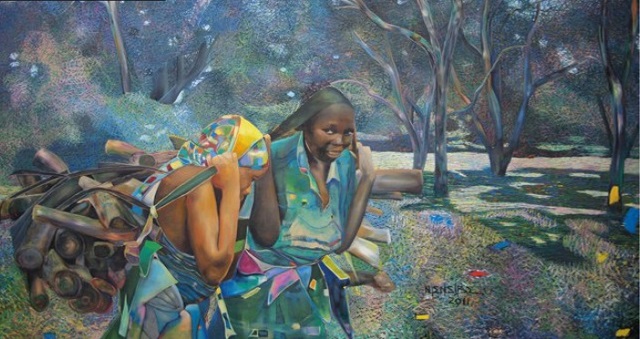
The odd link between Ntensibe and Klimt’s art
THE INDEPENDENT | DOMINIC MUWANGUZI | Gustave Klimt and Joseph Ntensibe can’t have been born and bred more differently. They lived and practiced their art in different periods and cultural worlds.
Klimt is an Austrian 19th Century painter who lived between 1862 and 1918 when art movements like symbolism, neoclassicism, romanticism, and Vienna secession prevailed. On the other hand, Ntensibe is a living Ugandan artist, born in Masaka; the rural district in south central Uganda, who likes rustic symbolism inspired by his rural childhood.
Yet their work shows amazing similarity. Both choose intertwining the human figures with geometrical patterns on canvases.
Klimt was among the generation of artists termed as `Art Nouveau’ who rebelled against already established concepts and styles in Europe- and decided to adopt it in his paintings. He preferred “provocative themes” of the nude. Although Ntensibe prefers to remain conservative, the similarity in execution connects them.
Klimt’s `Beethoven Frieze’ which is one of his most famous paintings- depicts three female figures: one pregnant with bare- sagging breasts, another tactfully covering her genitals and breasts with a folded leg and hair twirling down her bosom and the other hidden in the background. The painting is identical to `Hope ll, 1907-08’ that shows a woman figure pregnant and with bare breasts and elaborate shawl.
Ntensibe has a similar painting; of a man playing hide and seek with two or three ladies; one figure disappearing into another and emerging on the other side of the painting. With the same style, Ntensibe painted `Peacemaker’ portraying an older sister cuddling and embracing her two siblings. It is a gesture of love and responsibility.
The geometrical patterns noticeable in Klimt’s `The Kiss’ and other paintings are visible in the `Peacemaker’. It is amazing how the irregular shapes sometimes washed in a bright palette saturate Ntensibe’s work like in the series of `Disappearing (Budongo) Forest, 2011’. In Klimt’s most famous painting of all time; ` The Kiss, 1909’ the artist depicts two lovers embracing on the edge of a field of flowers.
It’s clear that regardless of the context within which they are working and generation they belong to, these are kindred creators of art. It is not imitation but a genuine response to a subject matched with artistic ingenuity and studio dexterity and technique.
The connection between Klimt and Ntensibe’s work shows that artists do not work in isolation of their surroundings, encounters, and times. Ntensibe with a background of art teaching may have come across Klimt’s work and was immediately struck by its unconventional approach. Today, Ntensibe is regarded as one of the greatest artists of his time in Uganda because he took that first step to learn and adopt what the masters like Gustave Klimt had done before. It formed his unique identity.
****
Ntensibe image courtesy of Startjournal
 The Independent Uganda: You get the Truth we Pay the Price
The Independent Uganda: You get the Truth we Pay the Price


